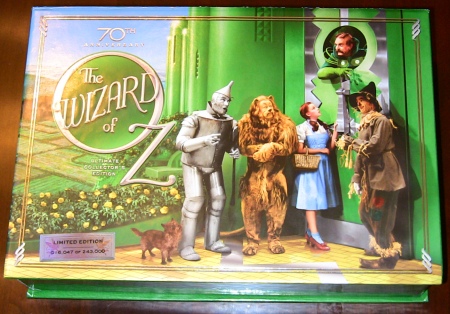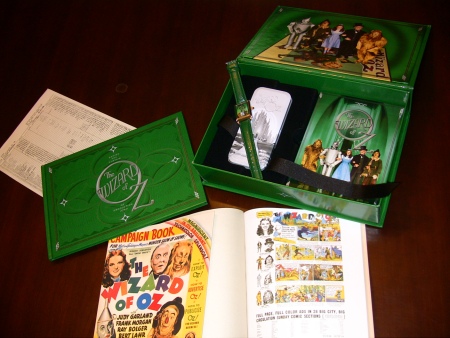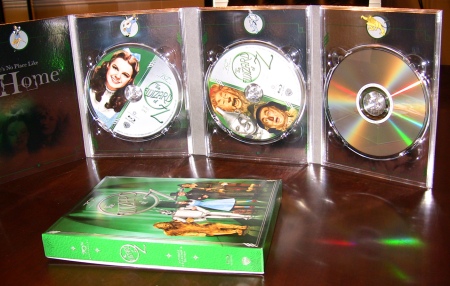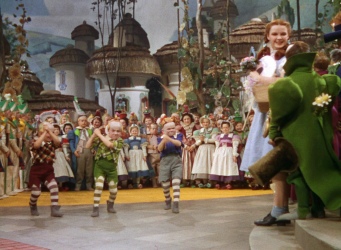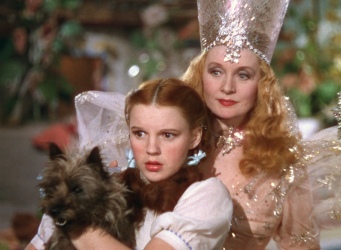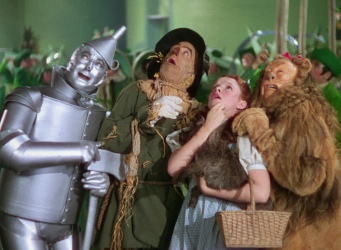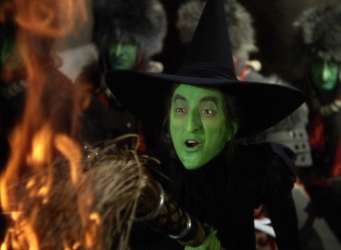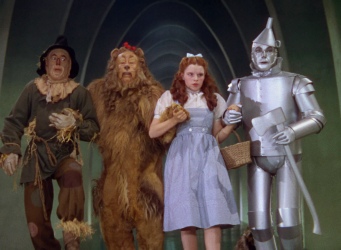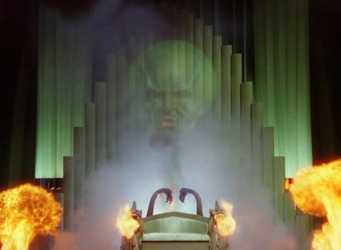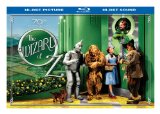| Reviews & Columns |
|
Reviews DVD TV on DVD Blu-ray 4K UHD International DVDs In Theaters Reviews by Studio Video Games Features Collector Series DVDs Easter Egg Database Interviews DVD Talk Radio Feature Articles Columns Anime Talk DVD Savant Horror DVDs The M.O.D. Squad Art House HD Talk Silent DVD
|
DVD Talk Forum |
|
|
| Resources |
|
DVD Price Search Customer Service #'s RCE Info Links |
|
Columns
|
|
|
Wizard of Oz, The
Warner Bros. // G // September 29, 2009 // Region 0
List Price: $84.99 [Buy now and save at Amazon]
"There's no place like home."
There's
also no film like The Wizard of Oz. Said to be the most watched movie in the history of cinema, Oz endures in a way that precious few have, still inspiring the same sort of infectious joy and wide-eyed awe today as it did seventy years ago. The Wizard of Oz is a showcase for the staggering talent and seemingly limitless resources of MGM in its prime: startlingly imaginative visuals that continue to dazzle today, perhaps the single most memorable soundtrack of any film ever made, and an exceptionally endearing cast to bring it all to life. More than just a wonderful movie, The Wizard of Oz is part of our culture...part of our vocabulary, and its entrancing magic hasn't dimmed in the slightest despite seven full decades having passed since it first roared into theaters.
Part of what's so captivating about this fairy tale -- the story of young Dorothy (Judy Garland) swept away from her dreary Kansas farm to a Technicolor wonderland of Munchkins, cackling witches, and magical ruby slippers -- is that everyone can relate. We all dream of something greater, perhaps without realizing what we already have in the first place. Its emotions and sensations are so pure: that sense of feeling hopelessly lost and afraid, the delirious joys of newfound friendship, the sting of disappointment when you've come so far and have seemingly nothing to show for it... Oz is such an impossibly bizarre land of magic and mystery, and yet its heart is grounded firmly in reality. That's why of all the towering achievements of The Wizard of Oz, perhaps its single greatest asset is Judy Garland. Dorothy is the window through which we view this strange and fantastic world, and Garland is so natural...so convincing as a young girl every bit as awestruck as we are that she shoulders much of the film on her tiny shoulders. I can't imagine much of anyone else who could've been anywhere near as warm, sweetly endearing, doggedly determined, and wonderfully childlike as Garland is in the role, but that voice...! Garland's singing is absolutely magnificent, and her stirring rendition of "Over the Rainbow" ranks with the title track from Singin' in the Rain as the most iconic and memorable of any silver screen musical. Astonishingly, it's revealed in the extras on this disc that the studio lobbied to remove "Over the Rainbow" from the film, and yet this song would go on to win an Academy Award and entrench itself in the public consciousness as few others ever would.
The Wizard of Oz is bolstered further by an exceptional supporting cast. Margaret Hamilton's turn as the cackling Wicked Witch of the West terrified children when the film was first released in 1939, and it's still the template that virtually all other witches, on-screen and off, have followed in the many years since. The sight of the Munchkins -- more than a hundred little people in their odd and startlingly vivid costumes -- continues to dazzle and delight. Billie Burke can't help but radiate comfort and joy as Glinda the Good Witch, and Frank Morgan deftly bounds from one role to the next with his own certain impish charm. I couldn't hope to choose a favorite between Dorothy's companions: the Scarecrow (Ray Bolger), the Tin Man (Jack Haley), and the Cowardly Lion (Bert Lahr), each hoping the great and powerful wizard can fill what they've been lacking in their lives. All three are absolutely wonderful, from the over-the-top bluster of the Lion to the way that the Tin Man, ironically enough, serves as the heart of the film. Watching The Wizard of Oz again, I can't help but
marvel at Ray Bolger's physicality as the Scarecrow. The rubbery-limbed dancer brings to life a bumbling character who really does seem as if he doesn't have any bones at all, and it's such a magical performance that even the most skilled computer animators these days could never hope to reproduce it. I'm sure it's no coincidence that all three of the actors playing Dorothy's friends originally hail from vaudeville, and they bring from that stage a certain oversized theatricality and sense of humor that mesh extraordinarily well with Judy Garland's more natural performance. At the same time, all three are terrific actors as well, and even with as many times as I've watched The Wizard of Oz over the years, I still find myself wholly escaping into their parts. MGM may have had more stars on their payroll than there are in the heavens, as the saying goes, but no matter how many actors they had at their fingertips, they could never hope to cast Oz any more perfectly than this.
MGM's craftsmen had earned a well-deserved reputation as the finest in the industry, and The Wizard of Oz is a testament to their talent. The scale and grandeur of Oz' vision of this fantastic land is still enthralling today. Again, many of its effects don't feel the least bit dated, from the terrifying sight of that cyclone carving a path of destruction to the hushed awe of Dorothy and her friends staring at the Emerald City from afar. Even with all of the matte paintings and visual tricks executed by the brilliant technicians at MGM, there's still a certain sense of tangibility...of being there...that just wouldn't be the same even with an $80 million CGI budget in the here and now. The studio spared no expense ensuring that the Land of Oz would be more dazzling and wonderful than any fantasy splashed across the silver screen, and this gorgeous high-definition remaster highlights just how remarkable their talents and attention to detail truly were. The original songs composed by Harold Arlen and E.Y. Harburg are so incredible and enduring that even the unfortunate few who've never watched The Wizard of Oz from start to finish can almost certainly at least hum along with "We're Off to See the Wizard", "If I Only Had a Brain", and "Ding Dong, the Witch Is Dead". They're not just infectiously catchy songs either, also serving to help tell the story and further flesh out these characters; for instance, nearly everything you need to know about Dorothy -- her longing for something greater than life as a Kansas farmgirl -- is contained within the few wistful minutes of "Over the Rainbow". The film's pacing as a whole breezes along remarkably well. There's a sense of forward momentum that never lets up, and Oz isn't distracted by any meandering subplots or rambling monologues, leaping from one marvelous setpiece to the next. By the same token, even with as visually dazzling as the film is, it never overindulges itself in spectacle for the sake of spectacle either: every last moment is essential and important. Needless to say, this is one of the most readily quoted films ever made as well. In every way possible, really, the construction of The Wizard of Oz is without equal.
Very few films are as timeless as The Wizard of Oz, and even with the quantum leaps made in technology and filmmaking techniques over the past seventy years, I can't conceive of an Oz more strange and wonderful than this. It's perfect, really: its startlingly ambitious visual scope that continues to entrance today, some of the most memorable songs ever written, a sensational slate of actors to send it roaring to life, and a sense of artistry, imagination, and magical wonder that rarely, if ever, have been equalled in the seven decades since. The Wizard of Oz frequently stands atop lists of the best children's movies of all time, and while that's certainly true, this is a film that transcends age. It inspires the same wide-eyed sense of awe and wonder in me now as it did when I first saw it theatrically as a child a quarter-century ago. Watching The Wizard of Oz again now -- that wistful sense of longing, the warm heart thumping away underneath, that terrific combination of vaudeville comedy with a fairy tale framework, the visual splendor of MGM at its peak, its deft mix of thrills and chills, its boundless charm -- the film is 102 minutes of infectious joy. I'm paraphrasing here, but for seventy years, this film has given faithful service to the Young in Heart, and Time has been powerless to put its kindly philosophy out of fashion. To those of you who have been faithful to it in return -- and to the Young in Heart -- its equally phenomenal release on Blu-ray is an essential addition to the collection of anyone in love with the magic of film. DVD Talk Collector Series.
Video
Breathtaking. Despite
having been remastered just a few short years ago, The Wizard of Oz has been newly restored for this Blu-ray release, and its 8K digital restoration eclipses anything I could ever have hoped to see. From the instant we first see Dorothy in the dreary, sepia-toned backdrop of her family's Kansas farm, I was astonished at the clarity and definition on display. That's just the start of it, though: once Dorothy opens her front door and steps foot into Oz, I found myself every bit as awestruck as she was.
It's almost impossible to believe that this is a film that's ringing in its seventieth anniversary. For one, the image on this Blu-ray disc is startlingly crisp and detailed. Even as the camera eased back, I felt as if I could count each and every one of the boxes on Dorothy's checkered dress. Seemingly every last hair in the Cowardly Lion's mane is clear and distinct, and likewise for the many thousands of flowers in the poppy field and the tiny flakes of snow sent falling from the heavens by Glinda. Even with as many times as I've watched The Wizard of Oz over the years, I'd never noticed the burlap texture to the Scarecrow's face before now. This Blu-ray disc isn't marred by any trace of awkward, automated processing either, remaining wonderfully filmlike from its first frame to the last. This is one of the most gorgeous representations of film grain I've had the pleasure of experiencing on Blu-ray. The Wizard of Oz is more closely associated with Technicolor than perhaps any other film, and from the neon green of the Wicked Witch to the brilliant gold of the yellow brick road, its vivid hues are more striking than ever.
The Wizard of Oz is a visually dazzling film, and this Blu-ray disc showcases the imagination, artistry, and unparalleled craftsmanship of MGM at its peak. There's a disappointingly widespread misconception that only movies from the CGI-era and on stand to benefit from the additional resolution that the format has to offer, but perhaps more than any other release to date, this Blu-ray disc should silence that ignorance. It's absolutely flawless, and even with as insurmountably high as my expectations for The Wizard of Oz were, this exceptional effort by Warner dwarfs even my highest hopes. It may sound like a shopworn cliché to say that this Blu-ray disc is like seeing The Wizard of Oz for the first time, but that sentiment really isn't that far removed. I suspect that this is the best the film has ever looked, and that includes its original theatrical run seven full decades ago.
The Wizard of Oz is pillarboxed to preserve its theatrical aspect ratio of 1.37:1, and the video on this dual-layer Blu-ray disc has been encoded with the studio's codec of choice, VC-1.
Audio
The Wizard of Oz includes both its original monaural soundtrack -- presented here in Dolby Digital 1.0 (192Kbps) -- as well as a newly-minted 16-bit Dolby TrueHD 5.1 track. It's worth noting that this remix doesn't take all that many liberties with the original sound design, but purists should still appreciate that a restored mono track is properly accounted for. The restoration of the audio isn't as overtly dazzling as this Blu-ray disc's high-definition visuals, but it's a remarkable effort just the same. The soundtrack is warm and natural throughout, and the faint hiss lurking in the background never once intrudes. Fidelity is understandably limited compared to more modern films, but the audio consistently remains clean and clear for every last moment. Some of the effects are balanced somewhat differently between these two tracks -- the chickens on the Gales' farm seem to be dialed down slightly in the remix, for instance -- and the TrueHD audio is certainly more full-bodied. Its bass response is modest and appropriate, such as the meaty thud of Dorothy's house careening to the ground in Oz and the thundering toms in the score. The TrueHD remix also benefits from a nice sense of directionality, from the light atmospheric color of a barking dog on Dorothy's farm to the Wicked Witch of the West blazing a path through the sky. These sorts of efforts never once come across as awkwardly forced or gimmicky, and the rear channels rarely draw attention to themselves. The nimble instrumentation of the music spreads out to fill every speaker, and it's in this way that the TrueHD track gains the most from this six-channel remix. The Wizard of Oz sounds wonderful on Blu-ray, and I'm thrilled to see that Warner saw fit to include its original mono soundtrack as well.
Though that original monaural audio has been included, it's hidden away under the 'Special Features' menu. For those who'd prefer to select the soundtrack with their remotes, the proper English mono track is the ninth option. More appropriately listed as an extra is a music and special effects track. This Blu-ray disc also features monaural soundtracks in French, German, Italian, Castilian Spanish, and Portuguese. Fourteen sets of subtitles have been included as well, among them streams in English (SDH), French, German, Italian, and Portuguese.
Extras
Oh, there's something in this black bag for you, Dorothy: The Wizard of Oz rings in its seventieth anniversary with one of the most sprawling special editions ever assembled, demanding more than twenty-four hours for its extras to be fully explored. The price and presentation can vary drastically by retailer; Wal-Mart and Target are each reportedly stocking their own pared-down versions, and the most elaborate and widely available edition is the boxed set reviewed here. The lavish box certainly isn't inexpensive, and those with less of an interest in its packaging or the more tangible extras ought to consider seeking out one of these slimmed-down sets instead. I have to admit to initially being skeptical about whether or not this "Ultimate Collector's Edition" was worth the asking price, but I was floored once I had the chance to hold it in my hands.
Each of these limited editions is individually numbered and comes packaged in a sturdy, lightly embossed cardboard box.
The centerpiece of this collection is The Wizard of Oz: Behind the Curtain of Production 1060. This 52 page hardcover book is beautifully designed, featuring dozens upon dozens of photographs as well as reproductions of original memos, pages from production notebooks, and even bizarre revision notes and excerpts from scenes discarded from earlier drafts of the screenplay. Behind the Curtain... prefers to tell the story of the making of the film visually, although there is a short textual introduction as well as brief biographies for each of the film's central actors. The book closes with some additional comments about L. Frank Baum and the TV movie about his life featured elsewhere in this collection.
This Ultimate Collector's Edition also features two reprints of material dating back seventy years. The first is a reproduction of its original budget sheet after principal photography wrapped, revealing that Oz exceeded the studio's estimated price tag by 60% -- the then-astonishing sum of more than a million dollars! One of the most impressive features of this boxed set is the gorgeous recreation of the campaign book issued to exhibitors in 1939. Newspaper art, pleas to cash in on the film's soundtrack, contest ideas to draw in the crowd that had made Snow White such a colossal success, displays, lobby cards, oil paintings, cutouts...everything from cardboard tire covers to soap sculptures are highlighted in this booklet. Its second half is devoted to a series of full page, full color ads and an extensive press book. This campaign book comes packaged inside its own heavy-stock folder summarizing the staggering scale of MGM's promotional machine at work.
Also included is a watch, itself packaged in a small, embossed tin case. A digital copy of the film for use on iPods and Windows Media-powered devices is packaged in its own sleeve separate from the other discs in the set. A teaser for the similarly lavish release of Gone with the Wind, offers for Fairies of Oz figurines and an Oz-themed charm bracelet, and a discount code for WarnerArchive.com are scattered inside as well.
There's also the matter of the film itself, of course. Rather than the familiar blue plastic, this three-disc set arrives in a reflective silver package that slips comfortably into an embossed sleeve.
Disc One
The Wizard of Oz also boasts an assortment of audio-only extras, each playing over a still of Dorothy and her friends approaching the Emerald City.
The first disc in this set is BD Live-enabled, although as of this writing, no exclusive features for The Wizard of Oz have found their way online.
Disc Two
This second disc in the set also offers a look at six other interpretations of Oz, including several produced by none other than L. Frank Baum himself.
Disc Three
The third and final disc in the set is a double-sided DVD featuring When the Lion Roars, a gargantuan six-hour documentary that chronicles the rise and fall of MGM. This 1992 documentary is divided into three segments, each hosted by a deliriously over-the-top Patrick Stewart. "The Lion's Roar" opens with the merger that created MGM and the factory mentality the studio would have to adopt to meet its ambitious goal of releasing a new feature film every week. This segment's primary focus is on the two forces that propelled MGM to become the largest, most successful, and most admired studio in Hollywood: wunderkind head of production Irving Thalberg and studio chief Louis B. Mayer. Each of their strengths -- Mayer's brilliance assembling such a sprawling roster of talent and Thalberg's golden touch as a producer -- are explored at length, and "The Lion's Roar" delves further into both the scandals and successes of this early era of MGM.
"The Lion Reigns Supreme" begins
as MGM is still reeling from the untimely death of Thalberg, leaving the studio entirely in the hands of Mayer, then the highest paid man in the nation. Mayer is by far the driving focus of this segment, from his emphasis on wholesome family entertainment to very different reflections on the man by the stars he'd helped foster to an obsession with race horses that essentially left MGM without a steward. "The Lion Reigns Supreme" takes a look at the new slate of actors and actresses to sign with the studio at the peak of its success during WWII as well as how its star was beginning to lose its luster. It's in this segment that The Wizard of Oz is featured, including comments from Munchkin Jerry Maren duplicated elsewhere throughout this boxed set as well as some discussion of the film's challenging visuals.
Finally, "The Lion in Winter" focuses on MGM's gradual decline after World War II: an era plagued by flop after flop, a barrage of corporate takeovers, unrelenting changes in management, the dissolution of the studio era, and the advent of television. This is a rather bleak segment -- charting the shuttering of MGM in the early 1970s, including footage of its immaculate backlots being bulldozed, and the tragic end of Judy Garland's Hollywood career -- but it's not all downbeat. It does encompass the golden age of the mighty MGM musical, after all, and "The Lion in Winter" delights in exploring the success of such films as Meet Me in St. Louis, Ziegfeld Follies, An American in Paris, Singin' in the Rain, Show Boat, and Gigi. This segment also touches on the shifting balances of power throughout Hollywood as a whole, including the arrival of such Method actors as Brando, the power of the producer making way for directors craving more creative control, and the reluctant embrace of darker themes and more graphic violence.
When the Lion Roars is, as its daunting runtime suggests, astonishingly thorough. The only topic I would've liked to have seen addressed that isn't touched on at all is MGM's success at animation. Otherwise, few stones are left unturned, aiming its spotlight at key members of the small army of technical talent on-staff at MGM, dozens of the studio's most notable films, and both the producers that steered such a mighty ship and the dazzling roster of talent that propelled it along. The documentary draws from newly-conducted -- as of 1992, at least -- interviews and a massive assortment of archival interviews, and, of course, excerpts from the many dozens of films highlighted throughout have been included as well. Some of the actors, directors, and producers featured here in interviews new and old are Katharine Hepburn, Mickey Rooney, Roddy McDowall, Cyd Charisse, Debbie Reynolds, June Allyson, Margaret Sullivan, Van Johnson, Ricardo Montalban, Groucho Marx, Charlton Heston, Gene Kelly, Joan Crawford, John Huston, David Lean, Judy Garland, Johnny Weissmuller, Richard Brooks, and Samuel Marx. Its sights are also aimed at Norma Shearer, John Gilbert, Erich von Stroheim, Lon Chaney, Greta Garbo, Clark Gable, Lionel Barrymore, Maureen O'Sullivan, Jean Harlow, Spencer Tracy, Vivan Leigh, Lana Turner, Hedy Lamarr, Buster Keaton, and Elizabeth Taylor, among quite a number of others. When the Lion Roars is a marvelous tribute to MGM and the tumult that brought about some of the most exceptional films in the history of cinema, and I'm thrilled that it's been included as part of this boxed set.
The Final Word
The Wizard of Oz is a timeless joy like no other: the dazzling Technicolor visuals, its deft blend of a classic fairy tale with a vaudevillian sense of humor, some of the most infectious music ever written for the screen, and an unrivaled cinematic magic that leaves me as entranced in wide-eyed awe now as when I first saw it decades ago. Said to have been seen by more people than any other film since the inception of cinema, The Wizard of Oz is more than just a movie. It's part of our heritage, and even seventy years later, The Wizard of Oz remains the standard by which all other fantasies are judged. Even all these decades later, it's certainly not difficult to argue that the artistry and boundless imagination of The Wizard of Oz have yet to be matched.
Several DVD releases of The Wizard of Oz have come and gone over the years, but it's near-impossible to conceive of a Blu-ray set more definitive than this sprawling special edition. Boasting a breathtakingly beautiful restoration and some twenty-four hours of extras, this lavish edition does just to the majesty of one of the most masterfully crafted and enduring films ever made. DVD Talk Collector Series.
Additional Screenshots
There's
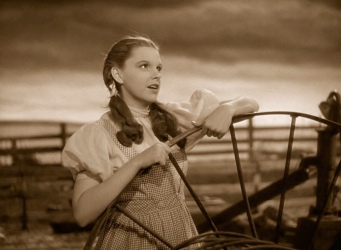 |
| [click on the thumbnail to enlarge] |
Part of what's so captivating about this fairy tale -- the story of young Dorothy (Judy Garland) swept away from her dreary Kansas farm to a Technicolor wonderland of Munchkins, cackling witches, and magical ruby slippers -- is that everyone can relate. We all dream of something greater, perhaps without realizing what we already have in the first place. Its emotions and sensations are so pure: that sense of feeling hopelessly lost and afraid, the delirious joys of newfound friendship, the sting of disappointment when you've come so far and have seemingly nothing to show for it... Oz is such an impossibly bizarre land of magic and mystery, and yet its heart is grounded firmly in reality. That's why of all the towering achievements of The Wizard of Oz, perhaps its single greatest asset is Judy Garland. Dorothy is the window through which we view this strange and fantastic world, and Garland is so natural...so convincing as a young girl every bit as awestruck as we are that she shoulders much of the film on her tiny shoulders. I can't imagine much of anyone else who could've been anywhere near as warm, sweetly endearing, doggedly determined, and wonderfully childlike as Garland is in the role, but that voice...! Garland's singing is absolutely magnificent, and her stirring rendition of "Over the Rainbow" ranks with the title track from Singin' in the Rain as the most iconic and memorable of any silver screen musical. Astonishingly, it's revealed in the extras on this disc that the studio lobbied to remove "Over the Rainbow" from the film, and yet this song would go on to win an Academy Award and entrench itself in the public consciousness as few others ever would.
The Wizard of Oz is bolstered further by an exceptional supporting cast. Margaret Hamilton's turn as the cackling Wicked Witch of the West terrified children when the film was first released in 1939, and it's still the template that virtually all other witches, on-screen and off, have followed in the many years since. The sight of the Munchkins -- more than a hundred little people in their odd and startlingly vivid costumes -- continues to dazzle and delight. Billie Burke can't help but radiate comfort and joy as Glinda the Good Witch, and Frank Morgan deftly bounds from one role to the next with his own certain impish charm. I couldn't hope to choose a favorite between Dorothy's companions: the Scarecrow (Ray Bolger), the Tin Man (Jack Haley), and the Cowardly Lion (Bert Lahr), each hoping the great and powerful wizard can fill what they've been lacking in their lives. All three are absolutely wonderful, from the over-the-top bluster of the Lion to the way that the Tin Man, ironically enough, serves as the heart of the film. Watching The Wizard of Oz again, I can't help but
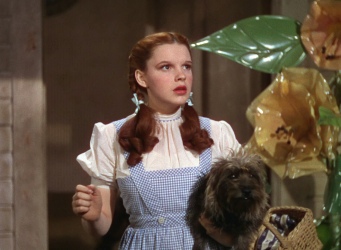 |
| [click on the thumbnail to enlarge] |
MGM's craftsmen had earned a well-deserved reputation as the finest in the industry, and The Wizard of Oz is a testament to their talent. The scale and grandeur of Oz' vision of this fantastic land is still enthralling today. Again, many of its effects don't feel the least bit dated, from the terrifying sight of that cyclone carving a path of destruction to the hushed awe of Dorothy and her friends staring at the Emerald City from afar. Even with all of the matte paintings and visual tricks executed by the brilliant technicians at MGM, there's still a certain sense of tangibility...of being there...that just wouldn't be the same even with an $80 million CGI budget in the here and now. The studio spared no expense ensuring that the Land of Oz would be more dazzling and wonderful than any fantasy splashed across the silver screen, and this gorgeous high-definition remaster highlights just how remarkable their talents and attention to detail truly were. The original songs composed by Harold Arlen and E.Y. Harburg are so incredible and enduring that even the unfortunate few who've never watched The Wizard of Oz from start to finish can almost certainly at least hum along with "We're Off to See the Wizard", "If I Only Had a Brain", and "Ding Dong, the Witch Is Dead". They're not just infectiously catchy songs either, also serving to help tell the story and further flesh out these characters; for instance, nearly everything you need to know about Dorothy -- her longing for something greater than life as a Kansas farmgirl -- is contained within the few wistful minutes of "Over the Rainbow". The film's pacing as a whole breezes along remarkably well. There's a sense of forward momentum that never lets up, and Oz isn't distracted by any meandering subplots or rambling monologues, leaping from one marvelous setpiece to the next. By the same token, even with as visually dazzling as the film is, it never overindulges itself in spectacle for the sake of spectacle either: every last moment is essential and important. Needless to say, this is one of the most readily quoted films ever made as well. In every way possible, really, the construction of The Wizard of Oz is without equal.
Very few films are as timeless as The Wizard of Oz, and even with the quantum leaps made in technology and filmmaking techniques over the past seventy years, I can't conceive of an Oz more strange and wonderful than this. It's perfect, really: its startlingly ambitious visual scope that continues to entrance today, some of the most memorable songs ever written, a sensational slate of actors to send it roaring to life, and a sense of artistry, imagination, and magical wonder that rarely, if ever, have been equalled in the seven decades since. The Wizard of Oz frequently stands atop lists of the best children's movies of all time, and while that's certainly true, this is a film that transcends age. It inspires the same wide-eyed sense of awe and wonder in me now as it did when I first saw it theatrically as a child a quarter-century ago. Watching The Wizard of Oz again now -- that wistful sense of longing, the warm heart thumping away underneath, that terrific combination of vaudeville comedy with a fairy tale framework, the visual splendor of MGM at its peak, its deft mix of thrills and chills, its boundless charm -- the film is 102 minutes of infectious joy. I'm paraphrasing here, but for seventy years, this film has given faithful service to the Young in Heart, and Time has been powerless to put its kindly philosophy out of fashion. To those of you who have been faithful to it in return -- and to the Young in Heart -- its equally phenomenal release on Blu-ray is an essential addition to the collection of anyone in love with the magic of film. DVD Talk Collector Series.
Video
Breathtaking. Despite
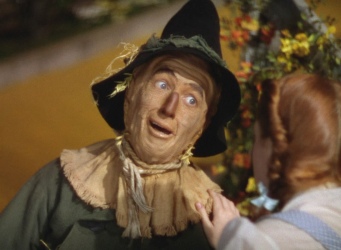 |
| [click on the thumbnail to enlarge] |
It's almost impossible to believe that this is a film that's ringing in its seventieth anniversary. For one, the image on this Blu-ray disc is startlingly crisp and detailed. Even as the camera eased back, I felt as if I could count each and every one of the boxes on Dorothy's checkered dress. Seemingly every last hair in the Cowardly Lion's mane is clear and distinct, and likewise for the many thousands of flowers in the poppy field and the tiny flakes of snow sent falling from the heavens by Glinda. Even with as many times as I've watched The Wizard of Oz over the years, I'd never noticed the burlap texture to the Scarecrow's face before now. This Blu-ray disc isn't marred by any trace of awkward, automated processing either, remaining wonderfully filmlike from its first frame to the last. This is one of the most gorgeous representations of film grain I've had the pleasure of experiencing on Blu-ray. The Wizard of Oz is more closely associated with Technicolor than perhaps any other film, and from the neon green of the Wicked Witch to the brilliant gold of the yellow brick road, its vivid hues are more striking than ever.
The Wizard of Oz is a visually dazzling film, and this Blu-ray disc showcases the imagination, artistry, and unparalleled craftsmanship of MGM at its peak. There's a disappointingly widespread misconception that only movies from the CGI-era and on stand to benefit from the additional resolution that the format has to offer, but perhaps more than any other release to date, this Blu-ray disc should silence that ignorance. It's absolutely flawless, and even with as insurmountably high as my expectations for The Wizard of Oz were, this exceptional effort by Warner dwarfs even my highest hopes. It may sound like a shopworn cliché to say that this Blu-ray disc is like seeing The Wizard of Oz for the first time, but that sentiment really isn't that far removed. I suspect that this is the best the film has ever looked, and that includes its original theatrical run seven full decades ago.
The Wizard of Oz is pillarboxed to preserve its theatrical aspect ratio of 1.37:1, and the video on this dual-layer Blu-ray disc has been encoded with the studio's codec of choice, VC-1.
Audio
The Wizard of Oz includes both its original monaural soundtrack -- presented here in Dolby Digital 1.0 (192Kbps) -- as well as a newly-minted 16-bit Dolby TrueHD 5.1 track. It's worth noting that this remix doesn't take all that many liberties with the original sound design, but purists should still appreciate that a restored mono track is properly accounted for. The restoration of the audio isn't as overtly dazzling as this Blu-ray disc's high-definition visuals, but it's a remarkable effort just the same. The soundtrack is warm and natural throughout, and the faint hiss lurking in the background never once intrudes. Fidelity is understandably limited compared to more modern films, but the audio consistently remains clean and clear for every last moment. Some of the effects are balanced somewhat differently between these two tracks -- the chickens on the Gales' farm seem to be dialed down slightly in the remix, for instance -- and the TrueHD audio is certainly more full-bodied. Its bass response is modest and appropriate, such as the meaty thud of Dorothy's house careening to the ground in Oz and the thundering toms in the score. The TrueHD remix also benefits from a nice sense of directionality, from the light atmospheric color of a barking dog on Dorothy's farm to the Wicked Witch of the West blazing a path through the sky. These sorts of efforts never once come across as awkwardly forced or gimmicky, and the rear channels rarely draw attention to themselves. The nimble instrumentation of the music spreads out to fill every speaker, and it's in this way that the TrueHD track gains the most from this six-channel remix. The Wizard of Oz sounds wonderful on Blu-ray, and I'm thrilled to see that Warner saw fit to include its original mono soundtrack as well.
Though that original monaural audio has been included, it's hidden away under the 'Special Features' menu. For those who'd prefer to select the soundtrack with their remotes, the proper English mono track is the ninth option. More appropriately listed as an extra is a music and special effects track. This Blu-ray disc also features monaural soundtracks in French, German, Italian, Castilian Spanish, and Portuguese. Fourteen sets of subtitles have been included as well, among them streams in English (SDH), French, German, Italian, and Portuguese.
Extras
Oh, there's something in this black bag for you, Dorothy: The Wizard of Oz rings in its seventieth anniversary with one of the most sprawling special editions ever assembled, demanding more than twenty-four hours for its extras to be fully explored. The price and presentation can vary drastically by retailer; Wal-Mart and Target are each reportedly stocking their own pared-down versions, and the most elaborate and widely available edition is the boxed set reviewed here. The lavish box certainly isn't inexpensive, and those with less of an interest in its packaging or the more tangible extras ought to consider seeking out one of these slimmed-down sets instead. I have to admit to initially being skeptical about whether or not this "Ultimate Collector's Edition" was worth the asking price, but I was floored once I had the chance to hold it in my hands.
Each of these limited editions is individually numbered and comes packaged in a sturdy, lightly embossed cardboard box.
The centerpiece of this collection is The Wizard of Oz: Behind the Curtain of Production 1060. This 52 page hardcover book is beautifully designed, featuring dozens upon dozens of photographs as well as reproductions of original memos, pages from production notebooks, and even bizarre revision notes and excerpts from scenes discarded from earlier drafts of the screenplay. Behind the Curtain... prefers to tell the story of the making of the film visually, although there is a short textual introduction as well as brief biographies for each of the film's central actors. The book closes with some additional comments about L. Frank Baum and the TV movie about his life featured elsewhere in this collection.
This Ultimate Collector's Edition also features two reprints of material dating back seventy years. The first is a reproduction of its original budget sheet after principal photography wrapped, revealing that Oz exceeded the studio's estimated price tag by 60% -- the then-astonishing sum of more than a million dollars! One of the most impressive features of this boxed set is the gorgeous recreation of the campaign book issued to exhibitors in 1939. Newspaper art, pleas to cash in on the film's soundtrack, contest ideas to draw in the crowd that had made Snow White such a colossal success, displays, lobby cards, oil paintings, cutouts...everything from cardboard tire covers to soap sculptures are highlighted in this booklet. Its second half is devoted to a series of full page, full color ads and an extensive press book. This campaign book comes packaged inside its own heavy-stock folder summarizing the staggering scale of MGM's promotional machine at work.
Also included is a watch, itself packaged in a small, embossed tin case. A digital copy of the film for use on iPods and Windows Media-powered devices is packaged in its own sleeve separate from the other discs in the set. A teaser for the similarly lavish release of Gone with the Wind, offers for Fairies of Oz figurines and an Oz-themed charm bracelet, and a discount code for WarnerArchive.com are scattered inside as well.
There's also the matter of the film itself, of course. Rather than the familiar blue plastic, this three-disc set arrives in a reflective silver package that slips comfortably into an embossed sleeve.
Disc One
- Audio Commentary: This commentary track
features notes -- largely culled from archival interviews -- from a diverse assortment of talent: Margaret Hamilton, Ray Bolger, Jack Haley, Munchkin Jerry Maren, producer Mervyn LeRoy, choreographer Dona Massin, make-up artist William Tuttle, discarded actor Buddy Ebsen, and even Barbara Freed-Saltzman (the daughter of producer Arthur Freed), John and Jane Lahr (the children of Burt Lahr), and Hamilton Meserve (son of Margaret Hamilton). The driving force of the commentary is Oz historian John Fricke, and his knowledge of the film is seemingly without limit. Fricke delves in-depth into casting, including naming a number of actors originally considered for each role, comparing and contrasting Oz with Baum's original novel, noting the contributions made by the many different writers and directors attached to The Wizard of Oz, and exploring some of the scenes that didn't find their way into the final cut.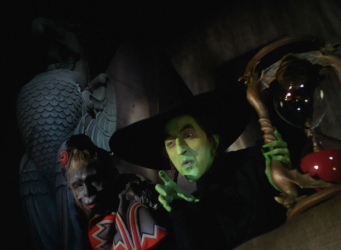
[click on the thumbnail to enlarge]
The highlights are too many to list, but to name a few...? MGM striving to excise "Over the Rainbow" out of the movie entirely, continuity gaffes, the precise construction of the ruby slippers, Judy Garland desperately wanting to buy Toto after filming had ended, everyday household items used to dye the Horse of Another Color, the 124 Munchkins featured in the film being only a fraction of what the studio had hoped for, music originally being intended to play throughout every frame of the film, other collaborations between the cast members outside of Oz, why the Jitterbug scene is better left on the cutting room floor, and Margaret Hamilton learning at a ball game that she'd earned the part of the Wicked Witch despite not having any idea that she was speaking to Louis B. Mayer himself. It's telling that even with as many hours upon hours of extras are offered throughout this enormous special edition, many of these notes are exclusive to the commentary. This is somewhat of a scholarly track, yes, but it's an incredibly rewarding listen.
- Sing-Along with the Movie: A subtitle stream with color-coded lyrics can be played over The Wizard of Oz in its entirety or on individually selected songs.
- Music and Effects Track: A monaural soundtrack without any of The Wizard of Oz' dialogue has been included as well.
- Still Galleries: The Wizard of Oz features eighteen individual still galleries with well over six hundred photos between them. "Oz on Broadway" highlights poster art from the stage production as well as a handful of photographs, and "Pre-MGM" is another mix of illustrations and actors in costume. "Sketches and Storyboards" paint an Oz darker and more ominous than what eventually made it to the screen. I was intrigued to see just how many interpretations of these characters were explored in a series of costume and make-up tests, and a separate gallery features some additional test shots of Buddy Ebsen as the Tin Man and a brief look at him in the siege on the castle.
"Oz Comes to Life" is easily the most sprawling of the galleries, featuring some 273 images. Seemingly every single scene is highlighted at length, and it's a mix of production stills, behind-the-scenes shots, a dollop of conceptual art, and even a production memo about a Munchkin-on-Munchkin death threat...? The largest of the remaining galleries is a series of playful portraits with the stars of the film, including shots of them marveling at an oversized Oz book. Other production galleries include a look at set design during Richard Thorpe's brief reign, a handful of candid behind-the-scenes shots, a special effects gallery that's more intensely focused on notes and memos, a post-production gallery heavy on belting out songs in the recording studio and a peek at the wardrobe, and even a number of photos from scenes that didn't make it into the final cut.
Also included are galleries of photos from the film's premieres in Hollywood and New York along with its stack of statuettes being accepted at the 1940 Academy Awards ceremony. One of the more extensive galleries focuses on press clippings, magazine covers, lobby cards, and poster art from The Wizard of Oz' original run, and similar promotional material for revivals and international releases are highlighted in their own sections as well.
The only disappointment, really, is that these shots seem to date back to the
Laserdisc era rather than rescanned to even DVD resolution, let alone HD. They're rather soft and riddled with nasty moire effects. Still, it's impossible not to be dazzled by the staggering scale of these galleries, and it ought to go without saying that there are quite a number of terrific shots scattered around in here.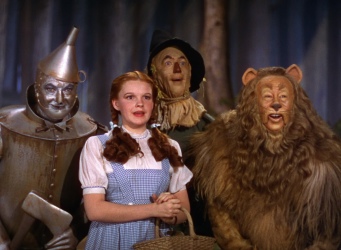
[click on the thumbnail to enlarge]
- Outtakes and Deleted Scenes (14 min.; SD): The most amazing footage here is the entrancingly elaborate "If I Only Had a Brain" dance number choreographed by Busby Berkeley -- complete with the Scarecrow being tossed around like a pinball and soaring high in the air -- that was trimmed down to near-nothing in the finished film. Although the footage of "The Jitterbug" snipped out after an early test screening has long since been lost, the upbeat swing number that went along with it is offered here, playing over a series of stills and home movies. "Triumphal Return to Emerald City" is a bigger production that would've been part of the film's final moments, and it too is played over a series of photos, including one that's more candid than you might expect. Last up is "If I Only Had a Heart", a vocal performance of Buddy Ebsen's that unspools over a series of photos and make-up tests of him as the Tin Man.
- Harold Arlen's Home Movies (5 min.; SD): Harold Arlen, one of the composers of The Wizard of Oz' timeless and infectious songs, was also an avid camera buff, and his 16mm home movies show the cast sitting for their portraits and also capture some candid footage on the set.
- The Wonderful Wizard of Oz: The Making of a Movie Classic (51 min.; SD): The first of the featurettes and documentaries on this Blu-ray disc is "The Wonderful Wizard of Oz", a twenty year old retrospective hosted by Angela Lansbury. The best of its stories are fielded in the audio commentary, but it's a thrill to marry some of those comments with visual accompaniment, such as the sight of a bright-eyed Shirley Temple quoting one of the novel's most iconic lines. Anyone thumbing through the campaign book in this Ultimate Collector's Edition will stumble upon dozens of references to Snow White and the Seven Dwarfs, and the competitiveness of what was then the highest grossing film in history is addressed at length here. Other subjects of note include a brief recap of L. Frank Baum's life, more than a hundred little people all together in one place and being individually measured by hand for their costumes, the 2nd and 3rd degree burns that could have cost Margaret Hamilton her life if her makeup had been left unchecked, where the voice of the Tin Man originated, and Oz' limited success in its initial theatrical run.
- The Art of Imagination: A Tribute to Oz (30 min.; SD): Narrated by Sydney Pollack, this 2005 retrospective has more of a technical and artistic bent. The daunting challenges of its visual effects, its ambitious production design, struggling with the headaches of Technicolor, and MGM's recent innovation of lip sync technology are among the topics fielded here. "The Art of Imagination" also devotes much of its runtime to The Wizard of Oz' music, including the orchestra deftly incorporating phrases from one song into the score and Oz being infused with a Broadway approach to its lyrics that were generally thought to not translate effectively to the silver screen. Marveling at the talent and artistry of the film are such filmmakers as director Peter Jackson, make-up effects titan Rick Baker, and composer Don Davis.
- Because of the Wonderful Things It Does: The Legacy of Oz (25 min.; SD): The Wizard of Oz didn't truly become a phenomenon until it started clawing its way to television in the 1950s. Its astronomical ratings made The Wizard of Oz an annual event, and "Because of the Wonderful Things It Does" chats with some of the people who considered their first viewings of Oz on TV to be a life-changing experience as well as its influence on seemingly every facet of pop culture, cosplay, a rabidly fierce collectors' market, and even the Oz festivals that have sprung up around the country.
- Memories of Oz (28 min.; SD): Produced for Turner Classic Movies, this retrospective touches on some unexpected facts, such as the film's props that would later be reused in other MGM films, an explanation why exactly that Dorothy would miss the Scarecrow most of all, and a gaggle of ducks that were accidentally dyed blue in the Munchkinland pond. The featurette as a whole is particularly Munchkincentric, nothing that the male little people tended to be slathered with more makeup than the women, that virtually all of the Munchkins were dubbed, and their reflections on Judy Garland. I believe this is the first of the video-based extras to spend any time focusing on Buddy Ebsen, an actor who's best known now for playing Jed
Clampett on The Beverly Hillbillies, but who knows what path his career might've taken if he hadn't had to spend a month and a half in the hospital reeling from an allergic reaction to the Tin Man make-up?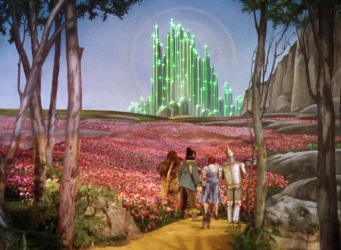
[click on the thumbnail to enlarge]
- The Wonderful Wizard of Oz Storybook (10 min.; SD): Angela Lansbury breezes through this greatly abbreviated version of L. Frank Baum's novel, complete with lightly animated illustrations. Though this ten minute take on Oz clearly leaves out quite a lot, it does hint at just how much was changed for the screen adaptation, including an army of mice spiriting Dorothy and her friends away from the poppy flowers, a trek to a different witch's castle as well, and Dorothy donning a set of silver slippers.
- Prettier Than Ever: The Restoration of Oz (11 min.; SD): Strangely enough, this featurette tackles the previous digital remastering of The Wizard of Oz rather than this latest restoration. I'm sure much the same idea applies, though, including inspecting all of the available elements, merging the three Technicolor records into one, and the painstaking process of removing dirt and scratches by hand. The restoration and remixing of the soundtrack is also addressed here, although curiously, there's an attempt to compare and contrast the original mono with its six-channel remix, yet the featurette itself is in stereo only.
- We Haven't Really Met Properly (21 min.; SD): These mini-featurettes delve into the backgrounds of The Wizard of Oz' stars and lob out some intriguing notes about each of them. For instance, Charley Grapewin acted in more than a hundred movies between the ages of 60 and 82, Toto wasn't a male dog like you might expect, and Jack Hale's son would go on to wed Judy Garland's daughter.
- It's a Twister! It's a Twister! (8 min.; SD): The original elements of Arnold Gillespie's spectacular tornado effects -- so remarkable that MGM would recycle this footage in two later films -- are replayed here in full and come complete with sound effects, even.
- Another Romance of Celluloid: Electrical Power (11 min.; SD): A dazzling Technicolor production like The Wizard of Oz demanded a mindboggling amount of light, and it follows that this means the shoot requires an enormous amount of power as well. This short subject takes a look at the electrical demands of a studio like MGM, and though it breezes through a number of other films as well -- including Huckleberry Finn, Broadway Serenade, and The Ice Follies of 1939 -- the highlight is a visit to the Oz set, complete with a different director in tow and a blonde Judy Garland.
- Cavalcade of the Academy Awards (2 min.; SD): This highlight reel assembled by Frank Capra features Judy Garland walking to the stage to perform "Over the Rainbow". The performance itself hasn't found its way onto this Blu-ray disc -- Capra mistakenly spliced in audio from the film instead -- but her introduction by Mickey Rooney (and, in turn, his introduction by Bob Hope) is included in full.
- Texas Contest Winners (1 min.; SD): A few lucky contest winners had a chance to putter around the MGM lot, and this snippet of promotional footage shows them meeting three of the vaudeville alums starring in The Wizard of Oz, including Buddy Ebsen.
- Off to See the Wizard (4 min.; SD): These animated bumpers, fielded by none other than the legendary Chuck Jones, aired as part of a series of family-friendly films on ABC. These include several versions of a gag that'd play halfway through each movie along with various teasers that'd lead into a clip from the next week's installment.
- Trailers (11 min.; SD): Six teasers and trailers -- spanning more than sixty years! -- have been included here, each opening with brief narration by Angela Lansbury.
The Wizard of Oz also boasts an assortment of audio-only extras, each playing over a still of Dorothy and her friends approaching the Emerald City.
- Jukebox: This jukebox
delves into the recording sessions behind The Wizard of Oz' wonderful songs: eighteen monaural tracks that run well over four hours in total. Among them are a weepy reprise of "Over the Rainbow", voice tests for the Munchkins, the unused Jitterbug number, and even quite a bit of the underscoring. Part of what makes this feature particularly intriguing is the inclusion of countdowns and various bits of background chatter in the studio.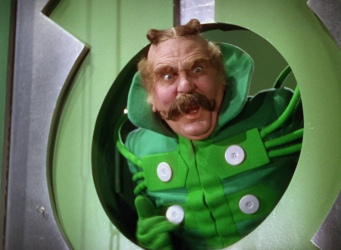
[click on the thumbnail to enlarge]
- Leo Is on the Air (12 min.): Several of the film's songs have been loosely strung together with narration for this radio promo.
- Good News of 1939 (61 min.): The season finalé of "Good News..." is a tribute to The Wizard of Oz, and the episode is offered here in its entirety, complete with unrelated comedy sketches and promos. Some of the Oz material has a canned, pre-packaged quality to it, such as Judy Garland learning she's landed the role of Dorothy followed by a jaunt over to the MGM casting office, but the music is really the star here. There are renditions of quite a number of the songs from the film, perhaps most memorably composer Harold Arlen singing "Over the Rainbow" accompanied only by a piano.
- Lux Radio Theater Broadcast (61 min.): Judy Garland returned to play Dorothy once again for this Christmas radio broadcast. It's particularly interesting to hear some of the adjustments made to accommodate the lack of visuals: Professor Marvel doesn't pretend that there's anything all that supernatural about his divining this young girl's troubles, and Dorothy recognizes that her new friends in Oz look uncannily like the farmhands back home. Somewhat frustratingly, the volume of this broadcast is obnoxiously loud compared to all of the other extras on the set. Be sure to turn your receiver down a few ticks before giving this feature a spin.
The first disc in this set is BD Live-enabled, although as of this writing, no exclusive features for The Wizard of Oz have found their way online.
Disc Two
- Victor Fleming: Master Craftsman (34 min.; SD): One of the most towering talents behind
the cameras at MGM earns his own half-hour biography. "Master Craftsman" takes a look at Victor Fleming making the transition from a bicycle repairman to working in seemingly every capacity imaginable in Hollywood, and having worn so many hats would prove to be an enormous asset once he settled in the role of director. One of just a handful of MGM's directors to make the transition from silents to talkies, Fleming's reputation at the studio as Mr. Fix-It left him spearheading several of their most colossal hits, including both The Wizard of Oz and Gone with the Wind. This biography explores the one-time ladies' man's strength at working with actresses, even those snidely shrugged off as talentless, and this gift would eventually spiral into the debacle of Joan of Arc shortly before his death in 1948.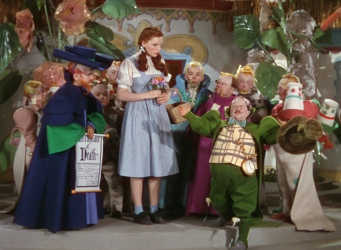
[click on the thumbnail to enlarge]
- L. Frank Baum: The Man Behind the Curtain (28 min.; SD): This biography of Oz' author is more thorough and more compelling than the exaggerated account elsewhere on the disc. "The Man Behind the Curtain" paints a much fuller picture, from initially being financed by his wealthy and exceptionally supportive family to the crushing blows that followed when he had to strike out on his own. This biography delves into his other ventures as well, including a wildly successful and long-running stage adaptation, a stint in radio that bankrupted him, and a slew of silent films he'd co-produced himself. It's an engaging look at the man, one driven by such a determination to capture every glimmer of an idea that he'd jot notes down on wallpaper, and it's also intriguing to hear that he found success writing an altogether different series of books under a pseudonym.
- The Dreamer of Oz (92 min.; SD): John Ritter and Annette O'Toole star in this heavy-handedly melodramatic 1990 TV movie based on the life of L. Frank Baum, leaning on a framing story of Baum's wife walking anonymously down the red carpet at the premiere of The Wizard of Oz in 1939. Despite suffering through a parade of failed business ventures and the tragic death of a niece, Baum is able to uplift his spirits as well as those of his children through the magic of his storytelling. Hints at the fixtures of Oz are interspersed throughout, culminating in his struggles to get his visually daring book published and the enormous success that quickly followed. It's mentioned in the accompanying book that this is the first home video release of the long-unseen The Dreamer of Oz, although those who've been holding out for it may be disappointed in just how poor its presentation is on this Blu-ray disc.
- Hollywood Celebrates Its Biggest Little Stars (10 min.; SD): This featurette documents the gala event swirling around the Munchkins being given their own star on the Hollywood Walk of Fame in 2007. Several of the surviving Munchkins speak about the honor and reflect on their experiences on the set nearly seven full decades earlier.
This second disc in the set also offers a look at six other interpretations of Oz, including several produced by none other than L. Frank Baum himself.
- The Wonderful Wizard of Oz (1910; 13 min.; SD): The first of the adaptations breezes through
the material astonishingly quickly, but its incoherence and low-budget charm are all part of the fun. One change from the more familiar 1939 film is that Toto is turned into a bulldog to better protect Dorothy, and that magical transformation is reflected here by a full-size man puttering around in an oversized dog suit. There are only a handful of intertitles, and I couldn't help but smile at how randomly characters just show up with little-to-no introduction.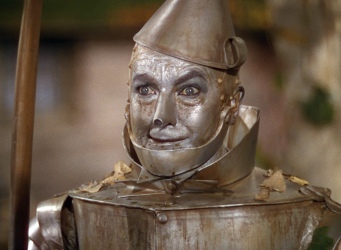
[click on the thumbnail to enlarge]
- His Majesty, the Scarecrow of Oz (1914; 59 min.; SD): Written and directed by none other than L. Frank Baum himself, this strange and wonderful film is teeming with romance! A giant crow dance party! A boxing kangaroo! A mermaid! A wandering princess with a frozen heart! Some poor schlub in a mule costume being whacked by two brooms at once!
- The Magic Cloak of Oz (1914; 43 min.; SD): Framed around a magical cloak that'll grant its wearer a single wish, this film swirls around a newly-minted, pint-sized king raiding the land's coffers for toy money, a donkey trying to rescue a girl kidnapped by a couple of robbers, and a gaggle of critters rising up in revolt. The highlight for me is a swarm of the almost perfectly round Rolly Rogues bumbling around.
- The Patchwork Girl of Oz (1914; 51 min.; SD): Penned by L. Frank Baum, the third and final of The Oz Film Manufacturing Company's surviving silent films focuses on a patchwork servant girl brought to life through magical powder. We get a sense of just how harsh the rulebooks in Oz are, including the leg-lopping law of the Hoppers and it being a criminal offense to snatch a six-leaved clover. This is the least ambitious visually of the three films Baum and his friends produced, but I do love the look of the Woozy, a sort of panther constructed out of what look to be cardboard boxes. Disappointingly, there is no backing music for The Patchwork Girl of Oz, leaving this film silent in the most literal sense.
- The Wizard of Oz (1925; 72 min.; SD): Directed by and co-starring Larry Semon, this intriguingly bizarre adaptation bears little resemblance to the novel or the 1939 film that followed. For instance, the Tin Man, the Scarecrow, and the Cowardly Lion are disguises adopted by Dorothy's farmhands, and a love triangle sparks the Tin Man to go on the attack. Curiously, there aren't any witches at all -- the villain here is a malevolent king -- and it's distracted by the mystery of Dorothy's parentage and even some uncomfortable racial stereotypes. This is by far the most lavishly budgeted of the other Oz interpretations on this disc, and it's certainly in the best shape.
- The Wizard of Oz (1933; 8 min.; SD): Finally, this animated Technicolor short marks the first portrayal of Kansas in dreary monochrome while the land of Oz is bursting with color. The great and powerful Oz is more of a sinister villain this time around, and again, the familiar touchstones -- Glinda, the Munchkins, and the Wicked Witch of the West -- are nowhere to be found.
Disc Three
The third and final disc in the set is a double-sided DVD featuring When the Lion Roars, a gargantuan six-hour documentary that chronicles the rise and fall of MGM. This 1992 documentary is divided into three segments, each hosted by a deliriously over-the-top Patrick Stewart. "The Lion's Roar" opens with the merger that created MGM and the factory mentality the studio would have to adopt to meet its ambitious goal of releasing a new feature film every week. This segment's primary focus is on the two forces that propelled MGM to become the largest, most successful, and most admired studio in Hollywood: wunderkind head of production Irving Thalberg and studio chief Louis B. Mayer. Each of their strengths -- Mayer's brilliance assembling such a sprawling roster of talent and Thalberg's golden touch as a producer -- are explored at length, and "The Lion's Roar" delves further into both the scandals and successes of this early era of MGM.
"The Lion Reigns Supreme" begins
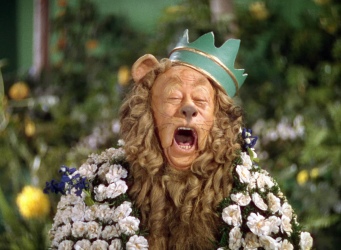 |
| [click on the thumbnail to enlarge] |
Finally, "The Lion in Winter" focuses on MGM's gradual decline after World War II: an era plagued by flop after flop, a barrage of corporate takeovers, unrelenting changes in management, the dissolution of the studio era, and the advent of television. This is a rather bleak segment -- charting the shuttering of MGM in the early 1970s, including footage of its immaculate backlots being bulldozed, and the tragic end of Judy Garland's Hollywood career -- but it's not all downbeat. It does encompass the golden age of the mighty MGM musical, after all, and "The Lion in Winter" delights in exploring the success of such films as Meet Me in St. Louis, Ziegfeld Follies, An American in Paris, Singin' in the Rain, Show Boat, and Gigi. This segment also touches on the shifting balances of power throughout Hollywood as a whole, including the arrival of such Method actors as Brando, the power of the producer making way for directors craving more creative control, and the reluctant embrace of darker themes and more graphic violence.
When the Lion Roars is, as its daunting runtime suggests, astonishingly thorough. The only topic I would've liked to have seen addressed that isn't touched on at all is MGM's success at animation. Otherwise, few stones are left unturned, aiming its spotlight at key members of the small army of technical talent on-staff at MGM, dozens of the studio's most notable films, and both the producers that steered such a mighty ship and the dazzling roster of talent that propelled it along. The documentary draws from newly-conducted -- as of 1992, at least -- interviews and a massive assortment of archival interviews, and, of course, excerpts from the many dozens of films highlighted throughout have been included as well. Some of the actors, directors, and producers featured here in interviews new and old are Katharine Hepburn, Mickey Rooney, Roddy McDowall, Cyd Charisse, Debbie Reynolds, June Allyson, Margaret Sullivan, Van Johnson, Ricardo Montalban, Groucho Marx, Charlton Heston, Gene Kelly, Joan Crawford, John Huston, David Lean, Judy Garland, Johnny Weissmuller, Richard Brooks, and Samuel Marx. Its sights are also aimed at Norma Shearer, John Gilbert, Erich von Stroheim, Lon Chaney, Greta Garbo, Clark Gable, Lionel Barrymore, Maureen O'Sullivan, Jean Harlow, Spencer Tracy, Vivan Leigh, Lana Turner, Hedy Lamarr, Buster Keaton, and Elizabeth Taylor, among quite a number of others. When the Lion Roars is a marvelous tribute to MGM and the tumult that brought about some of the most exceptional films in the history of cinema, and I'm thrilled that it's been included as part of this boxed set.
The Final Word
The Wizard of Oz is a timeless joy like no other: the dazzling Technicolor visuals, its deft blend of a classic fairy tale with a vaudevillian sense of humor, some of the most infectious music ever written for the screen, and an unrivaled cinematic magic that leaves me as entranced in wide-eyed awe now as when I first saw it decades ago. Said to have been seen by more people than any other film since the inception of cinema, The Wizard of Oz is more than just a movie. It's part of our heritage, and even seventy years later, The Wizard of Oz remains the standard by which all other fantasies are judged. Even all these decades later, it's certainly not difficult to argue that the artistry and boundless imagination of The Wizard of Oz have yet to be matched.
Several DVD releases of The Wizard of Oz have come and gone over the years, but it's near-impossible to conceive of a Blu-ray set more definitive than this sprawling special edition. Boasting a breathtakingly beautiful restoration and some twenty-four hours of extras, this lavish edition does just to the majesty of one of the most masterfully crafted and enduring films ever made. DVD Talk Collector Series.
Additional Screenshots
|
| Popular Reviews |
| Sponsored Links |
|
|
| Sponsored Links |
|
|
| Release List | Reviews | Shop | Newsletter | Forum | DVD Giveaways | Blu-Ray | Advertise |
|
Copyright 2024 DVDTalk.com All Rights Reserved. Legal Info, Privacy Policy, Terms of Use,
Manage Preferences,
Your Privacy Choices | |||||||









